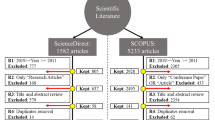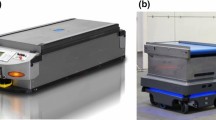Abstract
In this paper, we consider a hybrid production system with two distinct production lines, where one of them undertakes remanufacturing activities while the other executes traditional manufacturing tasks. The output of either production line can satisfy the demand for the same type of product without any penalties. The realization times for demand occurrences and service completions are random. In order to control such production systems, we propose a single-stage pull type control mechanism with adaptive kanbans and state-independent routing of demand information. The mechanism is modeled as a stochastic queueing network and performance measures are obtained for stationary behavior. Alternative static control policies are compared with the proposed policy with respect to an expected total cost function of these performance measures. An experimental design of L(2137) covering low to high traffic densities is utilized for the numerical analysis. The numerical comparison shows that on the average, the adaptive kanban control mechanism in consideration performs 20 % better than the best static kanban control mechanism.
Similar content being viewed by others
References
Thurston D, Bras B (2001) Systems level issues. In: WTEC Panel Report on Environmentally Benign Manufacturing of the International Technology Research Institute. Baltimore, Maryland, USA, April
Guide VDR, Kraus ME, Srivastava R (1997) Scheduling policies for remanufacturing. Int J Prod Econ 48:187–204
Guide VDR (2000) Production planning and control for remanufacturing: industry practice and research needs. J Oper Manag 18:467–483
Ferrer G, Whybark DC (2001) Material planning for a remanufacturing facility. Prod Oper Manag 10(2):112–124
Gupta SM, Veerakamolmal P (2001) Aggregate planning for end-of-life products. In: Sarkis J (ed) Greener manufacturing and operations: from design to delivery and back. Greenleaf Publishing Ltd, Sheffield
Kiesmüller GP (2003) A new approach for controlling a hybrid stochastic manufacturing/remanufacturing system with inventories and different lead times. Eur J Oper Res 147:62–71
Andrew-Munot M, Ibrahim RN (2012) Development and analysis of mathematical and simulation models of decision-making tools for remanufacturing. Prod Plan Control. doi:10.1080/09537287.2012.654667
Subulan K, Taşan AS (2013) Taguchi method for analyzing the tactical planning model in a closed-loop supply chain considering remanufacturing option. Int J Adv Manuf Technol 66(1):251–269
Zhang J, Liu X, Tu YL (2011) A capacitated production planning problem for closed-loop supply chain with remanufacturing. Int J Adv Manuf Technol 54:757–766
Barba-Gutierez Y, Adenso-Diaz B (2009) Reverse MRP under uncertain and imprecise demand. Int J Adv Manuf Technol 40:413–424
Ilgin MA, Gupta SM (2010) Environmentally conscious manufacturing and product recovery (ECMPRO): a review of the state of the art. J Environ Manag 91:563–591
Ilgin MA, Gupta SM (2012) Remanufacturing modelling and analysis. CRC Prss, Boca Raton, ISBN: 9781439863077
Ilgin MA, Gupta SM (2013) Reverse logistics. In: Gupta SM (ed) Reverse supply chains: issues and analysis. CRC Press, Boca Raton, ISBN: 9781439899021
Heyman DP (1977) Optimal disposal policies for a single-item inventory system with returns. Naval Logist Q 24:385–405
Muckstadt JA, Isaac MH (1981) An analysis of single item inventory systems with returns. Naval Res Logist Q 28:237–254
Laan van der EA, Salomon M, Dekker R, Wassenhove L (1999) Inventory control in hybrid systems with remanufacturing. Manag Sci 45:733–747
Inderfurth K, van der Laan E (2001) Lead time effects and policy improvement for stochastic inventory control with remanufacturing. Int J Prod Econ 71:381–390
Teunter RH, van der Laan EA, Vlachos D (2004) Inventory strategies for systems with fast remanufacturing. J Oper Res Soc 55(5):475–484
van der Laan EA, Teunter RH (2006) Simple heuristics for push and pull remanufacturing policies. Eur J Oper Res 175(2):1084–1102
Hsueh CF (2011) An inventory control model with consideration of remanufacturing and product life cycle. Int J Prod Econ 133(2):645–652
Akcali E, Cetinkaya S (2011) Quantitative models for inventory and production planning in closed-loop supply chains. Int J Prod Res 49(8):2373–2407
Korugan A, Gupta SM (1998) A multi-echelon inventory system with returns. Comput Ind Eng 35:145–148
Aksoy HK, Gupta SM (2011) Optimal management of remanufacturing systems with server vacations. Int J Adv Manuf Technol 54:1199–1218
Behret H, Korugan A (2009) Performance analysis of a hybrid system under quality impact of returns. Comput Ind Eng 56:507–520
Liberopoulos G, Dallery Y (2000) A unified framework for pull control mechanisms in multi-stage manufacturing systems. Ann Oper Res 93:325–355
Karaesmen F, Dallery Y (2000) A performance comparison of pull type control mechanisms for multi-stage manufacturing. Int J Prod Econ 68:59–71
Gupta SM, Al-Turki YAY, Perry FR (1999) Flexible kanban system. Int J Oper Prod Manag 19(10):1065–1093
Takahashi K, Nakamura N (1999) Reacting JIT ordering systems to the unstable changes in demand. Int J Prod Res 37(10):2293–2313
Moore KE, Gupta SM (1999) Stochastic colored petri net (SCPN) models of traditional and flexible kanban systems. Int J Prod Res 37(9):2135–2158
Tardif V, Maaseidvaag L (2001) An adaptive approach to controlling kanban systems. Eur J Oper Res 132:411–424
Sivakumar GD, Shahabudeen P (2008) Design of multi-stage adaptive kanban system. Int J Adv Manuf Technol 38:321–336
Takahashi K, Doi Y, Hirotani D, Morikawa K (2012) An adaptive pull strategy for remanufacturing systems. J Intell Manuf 1–17
Dingec KD, Korugan A (2013) A stochastic analysis of asynchronous demand in disassembly processes of remanufacturing systems. Eur J Ind Eng 7(2):175–205
Udomsawat G, Gupta SM (2008) Multikanban system for disassembly line. In: Gupta SM, Lambert AJD (eds) Environmental conscious manufacturing. CRC, Boca Raton, pp 311–330
Ilgın MA, Gupta SM (2011) Evaluating the impact of sensor-embedded products on the performance of an air conditioner disassembly line. Int J Adv Manuf Technol 53:1199–1216
Ilgın MA, Gupta SM (2011) Recovery of sensor embedded washing machines using a multi-kanban controlled disassembly line. Robot Comput Integr Manuf 27:318–334
Nakashima K, Kojima M, Gupta SM (2012) Management of a disassembly line using two types of kanbans. Int J Supply Chain Manag 1(3):11–19
Nakashima K, Gupta SM (2012) A study on the risk management of multi kanban system in a closed loop supply chain. Int J Prod Econ 139:65–68
Ahgajani M, Keramati A, Javadi B (2012) Determination of number of kanban in a cellular manufacturing system with considering rework process. Int J Adv Manuf Technol 63:1177–1189
Spearman ML, Woodruff DL, Hopp WJ (1990) CONWIP: a pull alternative to kanban. Int J Prod Res 28(5):879–894
Di Mascolo M, Frein Y, Dallery Y (1996) An analytical method for performance evaluation of kanban controlled production systems. Oper Res 44:50–64
Spearman ML (1991) An analytic congestion model for closed production systems with IFR processing times. Manag Sci 37:1015–1029
Korugan A, Gupta SM (2001a) A single stage kanban control system with dynamic routing. Proceedings of the 28th International Conference on Computers and Industrial Engineering. Cocoa Beach, FL, USA, pp 214-219
Korugan A, Gupta SM (2001b) A single stage kanban control system with static routing. Proceedings of the 2001 Annual Meeting of the Northeast Decision Sciences Institute. Pittsburgh, PA, USA, pp 227–229
Phadke MS (1998) Quality engineering using robust design. PTR Prentice Hall Inc., New Jersey
Author information
Authors and Affiliations
Corresponding author
Rights and permissions
About this article
Cite this article
Korugan, A., Gupta, S.M. An adaptive CONWIP mechanism for hybrid production systems. Int J Adv Manuf Technol 74, 715–727 (2014). https://doi.org/10.1007/s00170-014-5977-2
Received:
Accepted:
Published:
Issue Date:
DOI: https://doi.org/10.1007/s00170-014-5977-2




